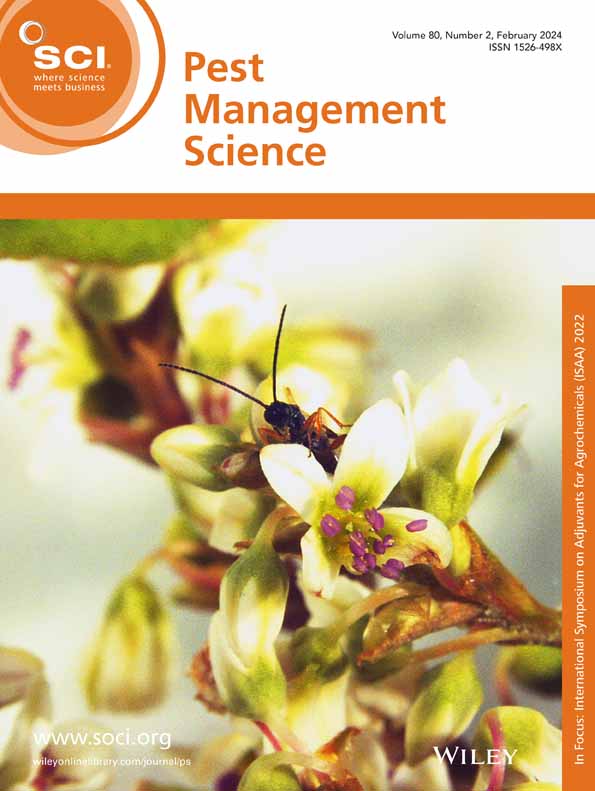转基因豇豆具有抗虫性和草甘膦耐受性
IF 3.8
1区 农林科学
Q1 AGRONOMY
引用次数: 0
摘要
豇豆是世界上最受欢迎的蔬菜。在中国,豇豆的嫩豆荚是主要的可食用部分。然而,豇豆在其整个生长周期中容易受到各种害虫的侵害。鳞翅目昆虫,包括豆荚螟(LPB, Maruca vitrata)、甜菜夜蛾(BAW, Spodoptera exigua)和烟草夜蛾(TCW, Spodoptera litura),是豇豆生产的主要害虫。传统的有害生物管理战略主要依赖化学农药,这不仅增加了生产成本,而且引起了对食品安全和环境可持续性的严重关切。转基因技术通过在植物中引入抗虫特性,为害虫治理提供了一种很有前途的解决方案。与转基因玉米和大豆不同,转基因豇豆的抗虫性尚未得到充分的开发和利用。结果本研究成功将Cry1Ab - Vip3A融合基因C1V3导入豇豆基因组。以草甘膦为选择源,采用改良转化方法获得了抗广谱鳞翅目害虫的转基因豇豆品系。从37个转基因事件中选择的一个有希望的品系CAP5,其特征是在豇豆基因组Chr5上具有单个T - DNA拷贝事件和单个插入位点。综合抗虫耐除草剂评价表明,CAP5对BAW、LPB和TCW具有较高的抗性,对草甘膦具有较强的耐受性,具有作为抗虫耐除草剂豇豆品种的应用潜力。结论表达Cry1Ab‐Vip3A融合蛋白和CP4‐EPSPS的转基因豇豆系CAP5对BAW、TCW和LPB具有较高的抗性,对草甘膦具有较强的耐受性。©2025化学工业协会。本文章由计算机程序翻译,如有差异,请以英文原文为准。
Transgenic cowpea conferring insect resistance and glyphosate tolerance
BACKGROUNDCowpea is a favorite vegetable around the world. In China, the tender pods of cowpea are the primary edible part. However, cowpea is vulnerable to a variety of pests throughout its entire growth cycle. Lepidopteran insects, including the legume pod borer (LPB, Maruca vitrata ), beet armyworm (BAW, Spodoptera exigua ), and tobacco cutworm (TCW, Spodoptera litura ), are the major pests to cowpea production. Conventional pest management strategies predominantly rely on chemical pesticides, which not only increase production costs but also raise critical concerns regarding food safety and environmental sustainability. Genetically modified (GM) technology offers a promising solution of pest management by introducing insect resistance trait into plants. Unlike transgenic corn and soybean, transgenic cowpea conferring insect resistance has not been fully explored and utilized.RESULTSIn this study, a Cry1Ab‐Vip3A fusion gene, C1V3 , was successfully introduced into the cowpea genome. Transgenic cowpea lines with resistance to broad‐spectrum lepidopteran pests were obtained by an improved transformation method using glyphosate as selection. A promising line, CAP5, selected from 37 transgenic events, was characterized as a single T‐DNA copy event with single insertion site at the Chr5 of cowpea genome. Comprehensive evaluation for insect resistance and herbicide tolerance indicated that CAP5 was highly resistant to BAW, LPB and TCW and exhibited strong tolerance to glyphosate, underscoring its application potential as an insect‐resistant and herbicide‐tolerant cowpea event.CONCLUSIONTransgenic cowpea line CAP5 expressing Cry1Ab‐Vip3A fusion protein and CP4‐EPSPS is highly resistant to BAW, TCW and LPB, and strongly tolerant to glyphosate. © 2025 Society of Chemical Industry.
求助全文
通过发布文献求助,成功后即可免费获取论文全文。
去求助
来源期刊

Pest Management Science
农林科学-昆虫学
CiteScore
7.90
自引率
9.80%
发文量
553
审稿时长
4.8 months
期刊介绍:
Pest Management Science is the international journal of research and development in crop protection and pest control. Since its launch in 1970, the journal has become the premier forum for papers on the discovery, application, and impact on the environment of products and strategies designed for pest management.
Published for SCI by John Wiley & Sons Ltd.
 求助内容:
求助内容: 应助结果提醒方式:
应助结果提醒方式:


